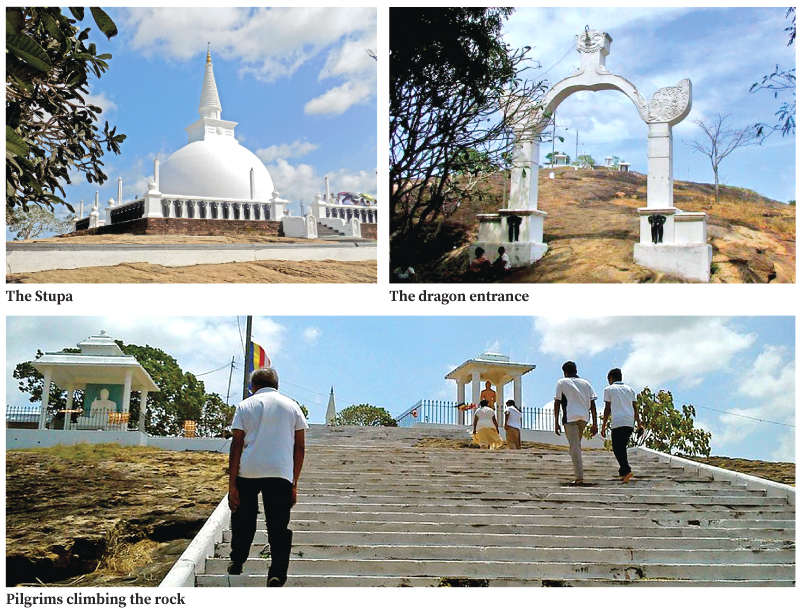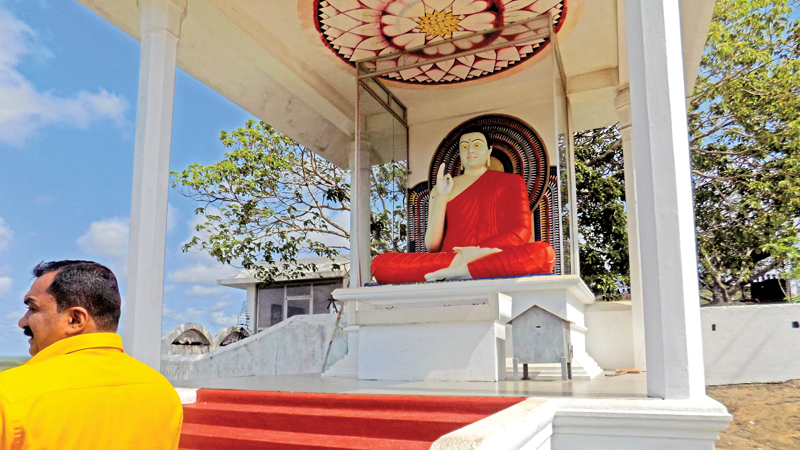Isinbessagala Ruwangiri Raja Maha Vihara is in Medawachchiya on the A- 9 (Kandy -Jaffna) highway. When you travel about two kilometeres from the Medawachchiya town you will come across a beautiful stupa on the top of a large rock with a name board ‘Isinbessagala’.
This is a part of the complex built by King Devanampiyatissa (250-210 B.C.) right after the introduction of Buddhism to Sri Lanka.
North bound travellers and pilgrims who travel to Anuradhapura or Mihintale often fail to notice the unspoilt beauty of this region nurtured by rich irrigation and Buddhist heritage.
Today, all you see at the top of the rock are recent constructions carried out in the first half of the 20th Century. The new stupa has been built on the same location where the original stupa was.
As visitors approach the temple premises, they are greeted by a magnificent entrance adorned with a carving of a white dragon. This entrance sets the tone for the spiritual journey ahead.
The main temple premises is behind this huge rock where the stupa can be seen. The main temple showcases exquisite architecture and intricate designs reflecting the rich Buddhist heritage of Sri Lanka. Devotees prefer climbing the rock to visiting the main temple premises.
Excavations carried out at the temple premises have revealed artifacts that provide evidence of the existence of the Naga tribal community that was in existence before the arrival of Buddhism. The ancient Naga Gala (Cobra carved stone) found during excavations proves this fact. The Naga Gala’s presence underscores the site’s cultural and historical depth. A Siri Pathul Gala (Footprint of the Buddha) too has been found.
According to the Viharadhipathi of the temple, the Siri Pathul Gala shows that people had worshipped the Siri Pathul Gala before Buddha statues were constructed. The cobra stone is now located in the ‘Bo Maluwa’ or the area where the Bodhi Tree lies and the Siri Pathul Gala is cleverly hidden away under a Buddha statue for protection from treasure hunters.
Visual reminders
Visitors can start their climb through the dragon entrance. From here is a gentle upward slope in the rock to the main stupa and the young Bo tree. Halfway up the climb, you can see a serene Buddha statue and a stupa of King Devanampiyatissa (250-210 BCE). These statues serve as visual reminders of the historical and religious significance of the complex.
Apart from its religious and historical importance, this temple offers a panoramic view of the surrounding landscape. From the rear of the main stupa, visitors can enjoy a 360 degree view of the entire area immersing themselves in the natural beauty of Sri Lanka.
From the rear of this stupa, you can climb down to the main temple premises behind the rock. Alternatively, you can take the gravel road just before the rock and drive straight to the main temple and climb from that side.
Arahath Guhawa
Within the temple premises, there is an ancient cave room with an ancient statue known as Arahath Guhawa. It has been used by bhikkhus and hermits for meditation.
Legend has it that Arahath Mahinda Thera along with other Bhikkhus were the first to reach this historical place before descending on Mihintale. The name Isinbessagala translates as – the rock on which sages descended. The word ‘Isi’ is derived from the Sanskrit word ‘rishi’(the sage)
King Devanampiyatissa played a pivotal role in propagating Buddhism and constructing Buddhist monuments across the country.
The establishment of this complex marks a significant milestone in the spread of Buddhism, symbolising the acceptance and integration of the Buddhist faith into the local culture. Isinbessagala Ruwangiri Raja Maha Vihara holds immense religious and historical significance for Sri Lankan Buddhists.
It serves as a place of worship and pilgrimage for devotees who seek blessings and spiritual solace. The temple is the focal point of the complex attracting devotees from far and wide.








